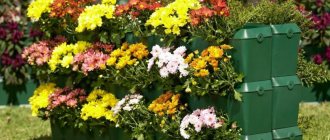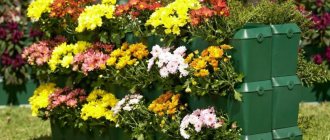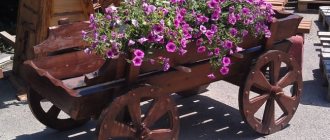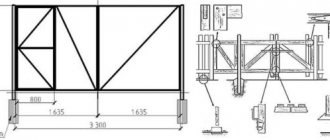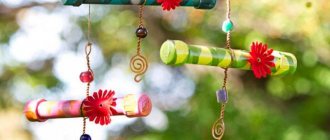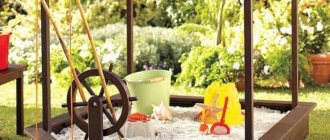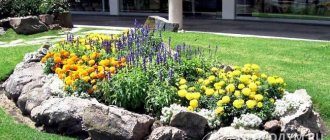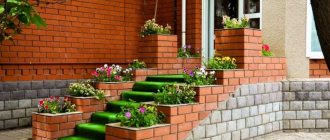Review author: Terrari School of Design
Amateur summer residents often do not know how to beautifully decorate their garden plot.
There are a wide variety of options for decorating a site. One of these is the popular type of landscape design - flower bed.
Decorative flower beds (photo) look organic and very beautiful in personal plots; they also help to disguise unsightly areas on the territory. Almost everyone without exception likes delicate floral scents; they lift the mood and pleasantly please the eye.
Flowerbeds are given an original shape mainly so that they attract attention, being the visual center of the flower arrangement.
With the help of a flower bed, you can easily and simply eliminate all the protruding unevenness in the landscape with your own hands. The right design technique will allow you to design the territory in both horizontal and vertical formats. If the land for planting is not very good, unpretentious plants can be planted in flower beds.
Creating a flowerbed with your own hands will help to beautifully decorate the area around the country house, but only if the designers and the owners themselves have a clear idea of what they will do and how correctly everything can be decorated.
Material for flowerbed design
Before creating a flower bed, it is important to select the material to create its border. Properly selected decorative fences will make the garden more interesting and easier to care for. Due to the fencing, grass does not grow into flower beds, and soil does not fall onto lawns and paths.
Decorative fences can protect flowers from trampling and visually separate them from paths and lawns. In order for a decorative fence to become a good protection against unnecessary grass, it must be made in the ground at a depth of about 25 cm.
There are a lot of different materials for decorating fencing. In specialized stores you can purchase ready-made finishing options, such as:
- plastic strips, strips, and barriers
- concrete palisades
- wooden pegs
You can also adapt natural materials (stones, tree debris, branches) or give a second life to things that have gone out of use (pallets, old bricks).
Flower beds with wide edges look very impressive. They can be made using large stones, bricks, sleepers, and concrete slabs. You can create a fence from crushed stone or gravel.
To ensure that the edge remains invisible, thin strips of plastic or metal are made; they are simply hidden under a layer of garden bark and litter. The edges of the flower garden are decorated with flowers of low-growing varieties.
By separating the flowerbed, you can make fences from unnecessary used things:
- glass bottles
- cans
- bricks
- roof tiles
- car tires
Plastic
As for plastic fencing for flower beds, empty bottles and other containers come in handy. There are many ways to use them:
- Cut in half and plant with flowers, repeating the option with a flower row.
- Dig into the ground up or down, repeating a standard wooden fence.
- Stick it into the ground (we form a high ridge, and insert bottles in rows on the sides).
It is also possible to build a high flower bed, for which the bottles installed on the neck are additionally fastened with wire or rope in two rows.
- News site
- Features of electrical wiring installation in houses made of SIP panels
- How to choose a cast iron bath
The main thing is not to forget to experiment with color. Also, no one forbids decorating the finished bed with plastic flowers from cut containers or laying out inscriptions from the lids.
Fencing made of large stones, boulders, concrete
Large natural stones are often used to decorate rocky gardens and flower beds. Large boulders look incredibly beautiful when enclosing a flower bed with tall flowers. Flowerbeds made of stones are easy to make yourself; they look very colorful.
The strongest and most resistant stone and concrete fences, they will last much longer than wood or plastic. They have excellent wear resistance and do not require constant maintenance. Concrete is a fairly durable material, excellent for creating edging in the form of low walls, strips that are flush with the ground.
Stone shaft
For builders and lovers of stone and concrete, a more durable option is to make a stone fence. We collect pebbles or boulders and place them evenly around the bed, fixing the structure with cement. The height, smoothness of the surface, width can be adjusted according to your wishes.
If there is an extra grid on the site, then we proceed differently:
- We measure the length of the ridge.
- We divide the resulting length into zones of 50 cm.
- Using the same step, we dig in metal pins or straight wooden posts.
- We fix a tensioned chain link between them.
- We fill the space in the grid with stones of various sizes.
Decorative fencing made of wooden pegs
For a summer cottage, a great idea would be to decorate a flower bed using wooden pegs. In summer cottages you can often find broken branches of trees, which are suitable for blocks with which you can make a flower garden fence.
Options for stone and brick fences
Original structures are created from brick and stone, differing in:
- strength and wear resistance;
- long service life;
- affordable price;
- resistance to negative environmental factors;
- resistance to mechanical loads.
Attention : powerful and capital stone fences can emphasize the fragility and grace of plants.
Gardeners use the following stones when constructing a fence for a flower bed:
- sandstone;
- marble;
- granite;
- volcanic tuff;
- slate.
Advice : when choosing natural stones, pay attention to their properties. For example, sandstone and limestone are easy to work with due to their soft structure.
Gabions (a mesh frame filled with stones) look very interesting. They will give the site rigor, conciseness and aristocracy. Such buildings are suitable for high-tech, minimalism, and modern styles.
You can lay out stone or brick flower beds using dry or wet methods. Each individual option has its own advantages.
In dry masonry, stones are laid out along the contour without mortar. For structural strength, it is enough to lightly dig in their lower part. Such structures are distinguished by quick assembly times and affordable costs. When laying wet, all stones or bricks are fixed together with a concrete mixture.
Tip: if you paint a stone fence with luminescent paint, then at dusk they will emit a soft and mysterious light.
Wicker fence
A decorative wicker fence, woven with your own hands, will add originality to the garden and help save money - a fence created by yourself costs absolutely nothing.
It is best to weave a fence from a vine, but you can use other flexible branches left after cutting down trees and bushes. Birch decorative barriers look very expressive. The height of the wicker fence should be approximately 0.4-0.6 meters.
The base of the fence is made from long, thick branches of willow or grapevine. First of all, pegs are placed around the perimeter - in the corners and along the walls. A frame is woven between the pegs to create a fairly dense fence. Very long branches are trimmed. Secure the walls with corner clamps.
Wicker fences for flower beds are ideal for naturalistic and rustic gardens, perfect for decorative flower beds of roses, tall plants, and ornamental grasses.
Branches
Look under your feet: branches torn off by the wind will become an excellent fence for flower beds made from scrap material. They can be stuck in rows around or woven into a solid fence. Another option is to tie it into a small long broom and lay out a ridge.
You can go the more difficult route:
- Dig several long sticks into the ground at the same height at a distance of 20-30 centimeters.
- Prepare a lot of flexible rods.
- Weave a fence, imitating basket weaving.
- If necessary, reinforce with rope or wire.
Fashionable and original solutions for designing flower beds
Ordinary pots and flower beds can be revived and transformed with the help of unusual ideas. Decorative flower beds can be made from all kinds of available materials. For this you will need:
- tires
- old stumps,
- tree trunks
- old furniture
- old buckets and watering cans
- plastic bottles.
Shoes can become very fun flower pots; you just need to fill them with soil and plant flowers.
Metal fences
A DIY iron fence for a flower bed can be:
- forged;
- welded;
- cast.
Forged and cast are made to order. They are distinguished by their exclusive appearance, delicacy, and sophistication. Only a qualified specialist with the necessary equipment and certain skills can make them with his own hands. Cast and forged fences will harmoniously fit into any design and become its bright decoration.
A welded structure can be made at home with a welding machine on hand. Combined products, for example, made of forged metal and monolithic iron, deserve special attention. And for a welded structure, it is enough to have pipe cuttings on hand. By welding metal pipes, simple geometric shapes are created. For such a fence, a trench is dug around the perimeter of the flowerbed, filled with concrete and pins are stuck in, to which the remaining elements are welded.
Spilled flowers
The popular design trend “spill flowers” has come to us. The flowers seemed to spill out of an overturned vessel. This design looks incredibly beautiful. This wonderful idea will decorate any garden. This could be a flat area, an area near a pond, or an alpine hill.
In the latter option, you can create a beautiful composition when a stream of flowers cascades down like a waterfall. You can use absolutely any vessel as a container. This can be not only an ordinary flower pot, but also a milk can or an old bucket.
The color palette is also varied and depends on the main landscape. White, yellow, pink flowers will look great on a lush bright green carpet. If the substrate is soil, gravel, or tree bark, you can choose options with darker colors: blue, purple, bright orange, burgundy.
What is important here is not the type of container, but the well-chosen flowers that “pouring” from it. Of course, these should be dense, low-growing plants for a flower bed. But a combination of simple low flowers also looks good: marigolds, petunias, primroses, pansies.
Advantages and disadvantages of flower beds in the yard
Fences for flower beds can serve not only as a decorative object, but also as protection for flowers. Before choosing a particular design option, it is important to familiarize yourself with all the possible pros and cons of the design. It is also important that the flower garden looks harmonious against the general background. For example, a certain version of the design may be suitable for a house made of timber, but at the same time it will look ridiculous against the background of a brick building. By choosing the right design option, you can diversify the familiar exterior and attract the attention of guests, neighbors and ordinary passers-by.
Pros:
- Flower stems are protected from lawnmowers.
- High sides and proper design can protect against damage caused by pets.
- Decorative fences for flower beds emphasize the beauty of flowers and make them more noticeable.
- Fenced and more elevated plants are much easier to care for and ensure their normal condition.
- Some materials are easy to get and cost pennies.
- You can realize your creative talent. The original shapes and patterns attract with their unusualness.
Decorative border Source derevyannyy.com
Cons
- Fencing flower beds takes up a lot of usable space.
- From time to time the structure needs to be monitored and taken care of on time.
- Some materials require large financial investments.
- It is very difficult to independently choose a flower planting scheme and a form of fencing construction.
Vertical flower bed from a pallet
In small gardens and loggias there is not much space, so you need to carefully plan the surface and choose the best solutions that will help you place more details while taking up less space. A vertical flower bed will allow you to plant many plants in a small area.
Old tires can be used to create raised beds - you just need to connect a few tires together. Old car tires filled with soil and flowers are probably the most common type of flower bed in dachas. Tires can be painted in bright colors, applied with an ornament or an interesting pattern, and hung on the wall.
Almost any of the presented materials can be used in several ways. The only limitation is the imagination of the owners of personal plots. It is important not to “overdo it” in such ingenuity and preserve the main task of the fence (fencing): to limit the surface of the flowerbed.
It often happens that for the sake of beauty, practicality is neglected and the decorative fence quickly becomes unusable. Therefore, it is better to use reliable, time-tested methods. A rim with uneven edges can create a risk of injury; unstable materials will quickly fail.
The result will be additional, unnecessary work, wasted time. Still, creating a flower bed is not like building a house, and anyone who has the desire can do it with their own hands, using these simple tips.
Types of fencing for flower beds
Fences for flower beds have different functional purposes, which means that fences are selected accordingly depending on the purpose of their use:
- Lawn and flower garden section. For this, a small fence, the height of which is no more than 7 centimeters, is sufficient.
- Border for a path or path. In this case, the fence should be more powerful, and its height should be 10-15 cm.
- Raised flower beds. It is best to cover them with stone or brick, since you need to keep the soil within a certain space. A strong and stable fence will allow the flower bed to remain unchanged for a long time.
- Root blocking. If you do not allow the flowerbed to grow beyond its limits, then you need to take care of high-quality fencing. The fence should go deep into the ground; it is best to use plastic or masonry; wood is not suitable.
- Protection from animals and children. If you protect plants from animals running around the territory or inquisitive children, then the fence must be installed high (about half a meter). To maintain visual appeal and aesthetic appearance, you need to use picket fences. The material can be metal, plastic or wood.
Photos of decorative flower beds
Glass fencing options
You can also make a fencing for a flower bed with your own hands from glass bottles. It will be inexpensive and will look quite unusual. To do this, do not be afraid to experiment and use any available materials. Despite the fragility of glass, the bottles will withstand sudden changes in temperature, high air humidity, and summer heat. For stability and strength, glass bottles should be filled with sand, gravel, and broken glass. For a bright design, all fillers can be painted.
The technology for laying fencing looks the same as using plastic bottles. That is, a shallow trench is dug into which glass containers are placed up or down with their necks and covered with earth. To give the flowerbed a special charm, the bottles are closed with identical corks and installed with the neck up at an angle. The top of the necks can be tied with bright threads and multi-colored wire. To build a medium-sized fence you will need up to 25 bottles. Such structures are usually used by gardeners when arranging flower beds with low-growing plants.
Wooden multi-tiered flower bed
What you definitely don't want to waste is wood products. Many gardeners have boards and old boxes lying around unused. They can easily be enlivened with flowers.
But first you will have to find as much wood as possible or ready-made products of different sizes in order to build a 3-5-tier flower bed.
Boxwood: planting, care, growing in open ground, propagation. Full description of the plant from A to Z. More than 100 photos of evergreen shrubs- Living fence - the best ideas on what to make a hedge from at your summer cottage. Many photos of ready-made options with exclusive designs + instructions
- Trimming bushes - the basics of choosing the right plants and forming the right shapes, selecting tools (photo + video)
And since wood rots and dries out over time, it is recommended to prepare thematic material before use:
- Firstly, the array is cleaned and polished if necessary;
- Secondly, the material is treated with an antiseptic for moisture resistance;
- Thirdly, the facade part is painted.
It’s good if the wood is already represented by several boxes. Then, from the latter, a multi-tiered flower bed is erected in just a few minutes. If necessary, the drawers can be reinforced with screws.
Many gardening enthusiasts use a stump as a multi-tiered wooden flower bed. To make recesses inside it for a flower bed, you will have to work with a chisel, hammer and drill.
Before planting, it is recommended to treat the holes with an antiseptic and make holes through the array so that moisture does not remain inside the stump.
Location
More often, flowering corners are arranged near the house or gazebo, but shade-loving varieties are planted in the garden between trees, providing access to them with landscaped paths.
Do-it-yourself flower beds and flower beds play the role of framing paths or individual zones and can be round, oval, square, or rectangular in configuration.
A mixborder laid out with a certain pattern is in demand. Flower beds can form islands, have a stepped structure or vertical planting that saves space. The maximum height of flowers in the center gently decreases towards the edges.
The place for climbing specimens is near the fence, the walls of the gazebo and next to small architectural buildings. Representatives of the flora should have enough light, the distance between them should be maintained taking into account further growth.
What plants can you plant?
In vertical flower beds, flowering annuals maximize the beauty of their climbing form: petunia, lobelia, nasturtium, violets, balsam, sutera. Green leafy plants are also suitable, the tiered arrangement of which will perfectly emphasize their shape: chlorophytum, fern, daylily.
The photo shows an example of a voluminous vertical flower bed in the shape of an arch.
Bushy plantings are also suitable: lush begonias, jasmine, coleus, alyssum. Plants with an extensive root system should be avoided.
Experienced gardeners use vertical beds to plant strawberries, basil, rosemary and mint. They don’t need a lot of soil for their growth, but the moisture needs to be carefully monitored. Before strawberries bloom, it is imperative to apply complex fertilizers.
Multi-tiered flower bed - basic rules
Let's assume that the design for the flower bed has already been created or is in thought. Then all that remains is to choose the right plants for it.
Here you must be guided by the following rules:
- The flora should stand out against the general background of the landscape, so the latter should be one color - lawn, fence, wall of a residential building;
- The image of a multi-colored flower bed is created not only by flowers, but also by bright vegetation - caladium, hosta, heuchera;
- Tall flowers are best placed in or behind to protect medium- and short-growing neighbors;
- The effect of different levels can be achieved by combining both tall and low multi-colored flowers in one flower bed;
- It is important not to forget about the beginning and duration of flowering of plants, so that the flowerbed pleases the eye all season;
- On the lower tiers, shade-tolerant and moisture-loving crops are grown, on the top – more or less resistant to zenith and drought;
Flowerbed designs vary in color, size and shape.
It happens that the color scheme is represented by only two flowers, but the shape is so unique that the participants of the flower garden perfectly intertwine with each other. And yet the flowers paint the tiers, and not vice versa.
